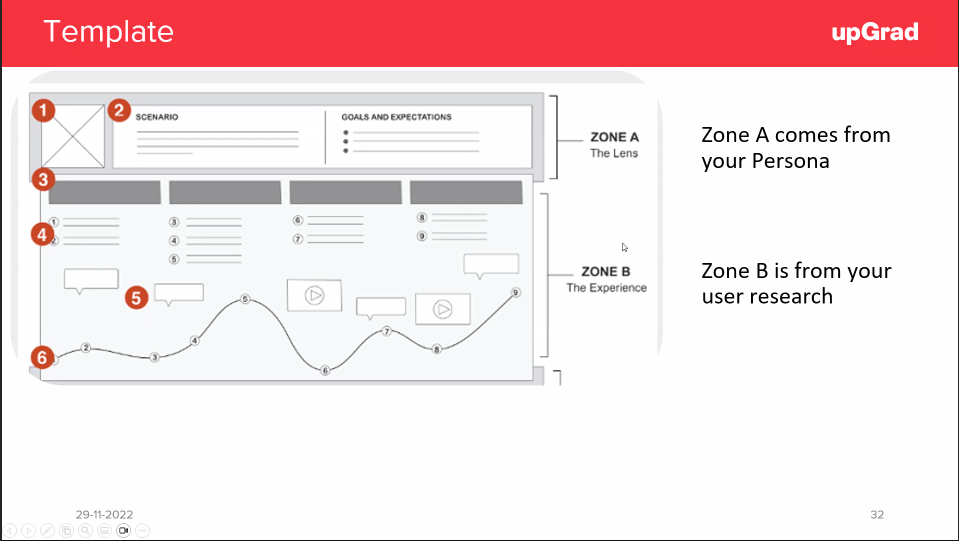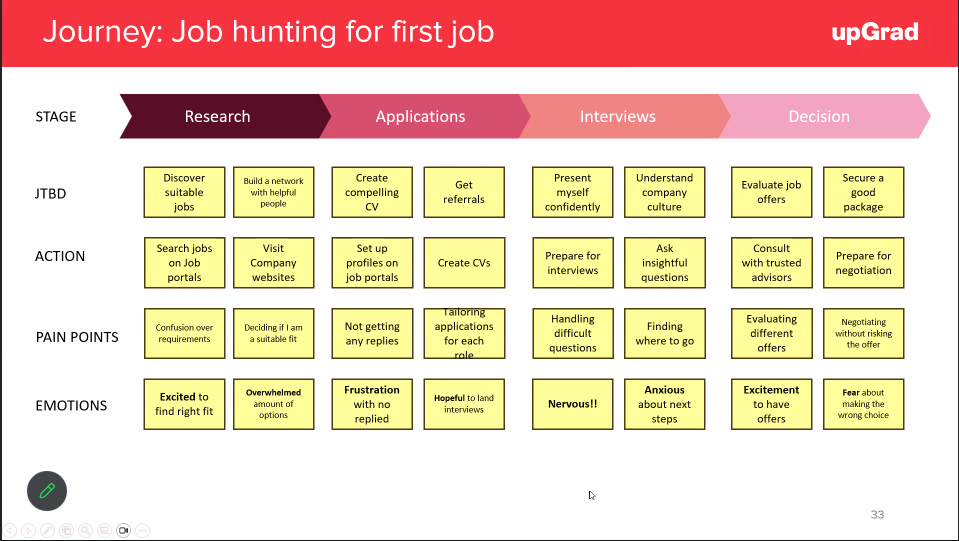Learning Objective
-
Examine the various ways to synthesize the findings from user research and use them to create user artifacts
-
Building persona maps
-
Big Picture
- Process User research to creating usefaul artifacts
-
How to create user artifacts
Big Picture
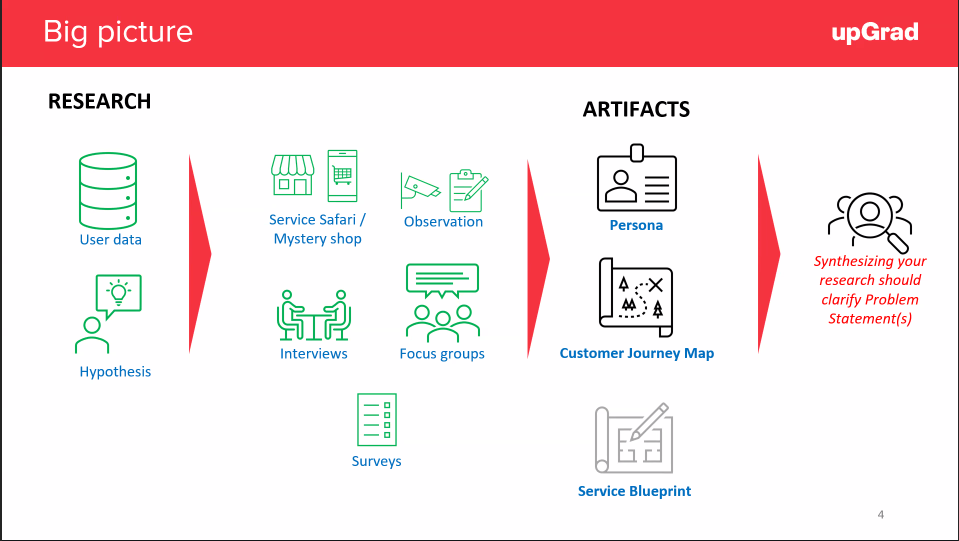
How to Synthesize User Research
- 3 step process
- What to we need to know to be more successful here?
- What are the questions we need to ask?
- Interview - talk to a variety of usres and ensure the decisions we make are the right one
- Use post-its with colour codes
- Find patterns
- Dig into raw data and mind map stuff - this is called affinity mapping
- Use Mural to put this data into a more visual flow - alternative tool is miro
- Multiple hypotheses should be split into separate murals and then colour code and synthesized separately
Analyze data and form personas
- Persona - it is a profile that represents a particular group of people
- It is not a stereotype but an archetype based on research
- They are used to challenge existing stereotypes
- How to use
- They can be used to find
- They can help with buy-in
- Empathy - most important - eg life size cardboard cutouts they bring to meetings
- How to create?
- Goals, needs, and wants
- Talk to your customer
- Draw on what you have - CRM, analytics, order history and so on
- Create a draft of your person with pen and paper
- Give a name and face to each persona to create empathy
Artifacts
Artifacts are the common understanding of the persona
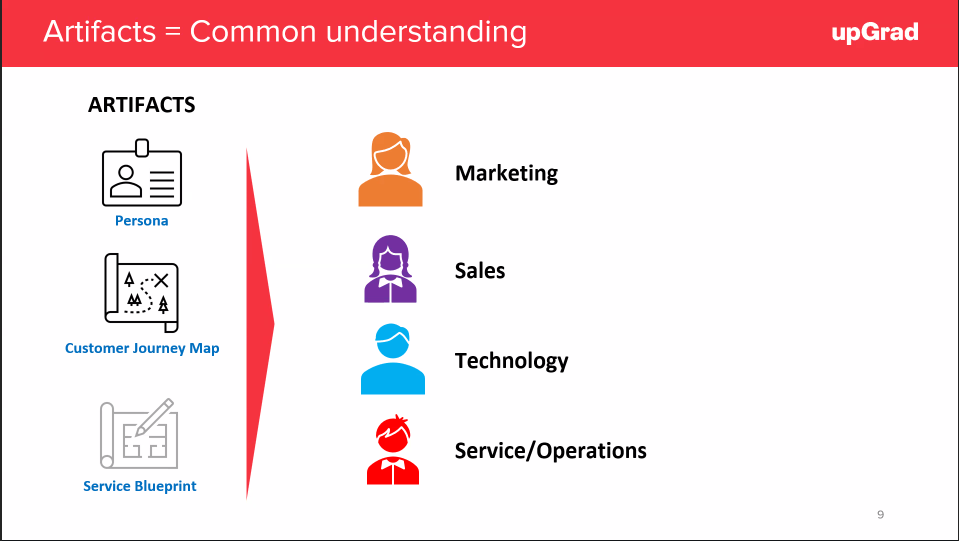 Persona, customer journey map and service blueprint to marketing, sales, technology, service/operations
Persona, customer journey map and service blueprint to marketing, sales, technology, service/operations
Example
Yusuf
A recent graduate from college/university that is struggling to find a full-time job
- Needs (jobs to be done)
- what is he trying to achieve - functional, emotional and social
- Identify suitable jobs
- Create an attractive CV
- Apply for jobs
- Perform well in interviews
- Assess job offers and decide
- What are the pain points
- What challenges is Yusuf facing when he is going through hes journey to solve his problem?
- He doesn’t know how to hunt for a job
- Not surrounded by people who can help him
- Psychographics
- Attitude or values - things he might not want to show on a public level
- He is reluctant to show he is struggling
- He thought it would be easy
- Demographics
- 22-24 years old
- Unemployed
- Living at home with family
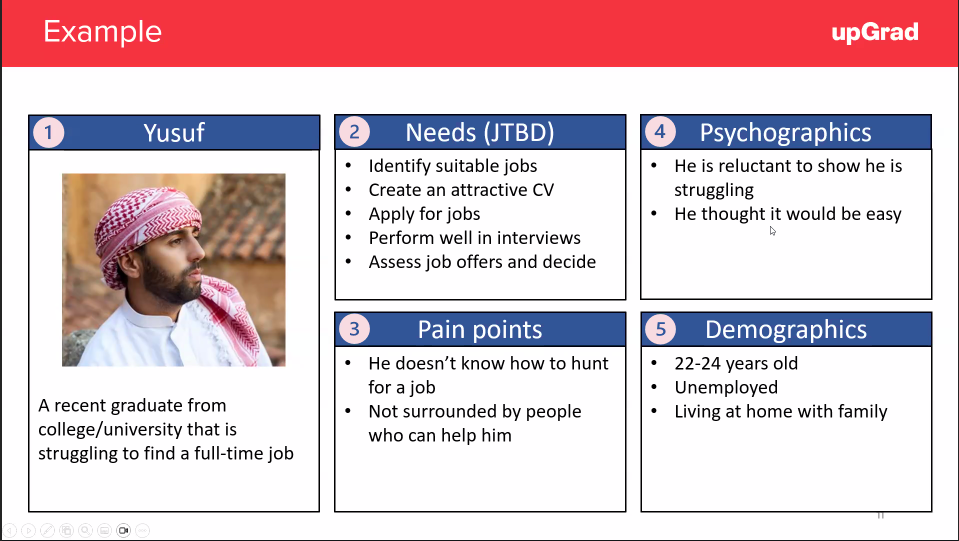
Experience sharing using GenAI
Hypothesis: Many Canadians and Brits are tired of paying high taxes and want to consider moving to Dubai. What kind of services would be desirable to help them make the transition?
- Personas + Pain points
- Existing challenges in relocating
- Map out the CJM (Customer Journey Map) for each personal
- Highlight common pain points?
- How are they solving their pain points today?
- What services could they value?
How to develop personas
- Start internally - build hypotheses about different customers. Use data you already have, including some insights from people
- Create a research plan
- Focus groups
- Interview them
- Plan B - if you cannot interview actual customers, then interview colleagues in customer-facing roles as a proxy
- Agree on the format for the final personas artifact
Example
- You work for a fintech start up and its main investor is a bank
- They believe that there is an opportunity to create a loan product for digital nomads and that this is a growing market
- Preliminary research has shown that digital nomads are consistently denied loans because of their unconventional income patterns
Step 1 - Prelim research
- They believe that there is an opportunity to create a loan product for digital noamds and taht this is a growing market
- Data shows that they are consistently denied loans due to their unconventional income patterns
Step 2 - User Research
- Run a screener survey to find people who associate with being a digital nomad
- 320 people answer positively (out of 1000 survey respondents)
- Send invites to all these 320 people for an online focus group (with money allocated to their research budget)
- 20 people participated, 3 focus groups
- Survey created with a goal to have 400 completed surveys
- First 2-3 screener questions qualified respondents in or out
- 417 qualified responders completed the survey after 4 weeks
Step 3 - Synthesis
- Customer segments
- Freelancers - approx 30-40%
- Remote employees - approx 25-35%
- Entrepreneurs - approx 15-25%
- Contractors - approx 10-15%
- Challenges, needs, lifestyle and attitudes could be very different for each above so we will need a persona for each one, however the initial focus will on the freelancers as they are the largest group and have the most challenges to overcome.
Step 4 - Create personas for each segment
- Quen - Freelancer - reps 10 of 1000s of freelancers
- Work in diverse range of fields such as writing, GD, programming
- They work on multiple projects
- New freelancers typically struggle the first 2-3 years
- Goals
- Buy an apartment
- Wants to pay off her property within 5 years
- She hopes to make further investments in the years ahead that will generate passive income
- Demo
- Gender - irrelevant
- Age - 30 - 40
- Country - higher percentage come from NA and EU
- Income - 80 to 120k USD per year
- Challenges
- Wild swings in income on a monthly basis
- While average monthly income exceeds requirements, some months do not meet the minimum
- High taxes income in home country encourage them to move
- Travel often so not always in same country
- Expectations
- Incoming to continue to grow by 10% each year
- Banking show be 100% digital
- I have high annual income and good savings so I should be an attractive customer
What information can we include in a persona
- Job to do - what is the customer trying to achieve
- Gains - what do they like about existing products
- Pains - what do they dislike about existing products to serve their needs
- Use cases - what are the situations when they will use your product
- Lifestyle - are they adventurous, image driven, conservative
- Behavior - digital first, full service
- Demographics - gender, age, income, education
Jobs to be done
The JTBD theory focuses on understanding the underlying motivations and needs that drive people to use products or services
- Functional - Rolex watch can tell the time
- Emotional - this is a nice _________ gift
- Social - this represents how I want to be seen by others (successful)
How are personals helpful in PM?
- They should answer: who are our target customer, what probelm they have, why they have that problem, how they think/behave, where we can find them
- This informatino then allows tous to understand
- What value we need to creat eith out proudtc
- What the optimal user ex would be
- How to find them
- Who best to communicate the value prpoosition of our prod or service
Customer Journey Map
- Start with pen and paper
- Include customers and multiple depts
- Choose a scope - high level showing end to end or detailed map showing one part of the journey
- Ex: Mortage loan - show 30 years of that from searcihing, living and making payments
- Choose a persona - choose a main actor - grpup of customers or employees - ex: comapring customer exp with thoser of employees
- Steps
- Any expericne an actor has - interaction with another person or HMI
- Can be walking or waiting for example
- Decide what is the most curicial part and ask what comes before and after this
- Lanes - add lanes to show more context - storyboard - or add more text or add a graph showing the emotional journey lanes
